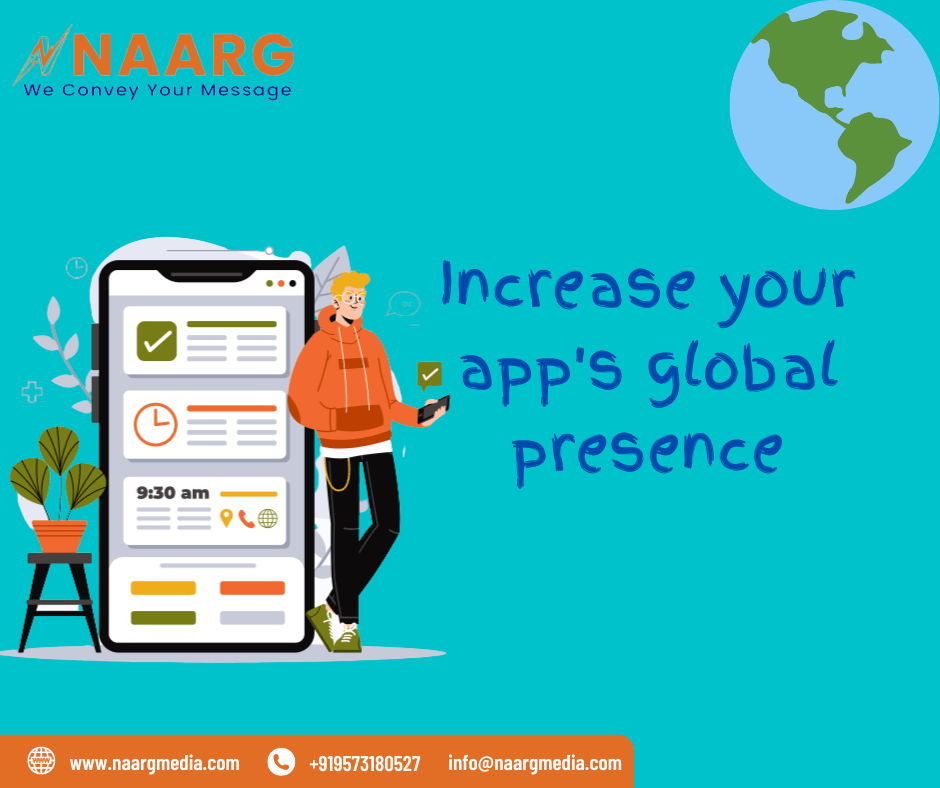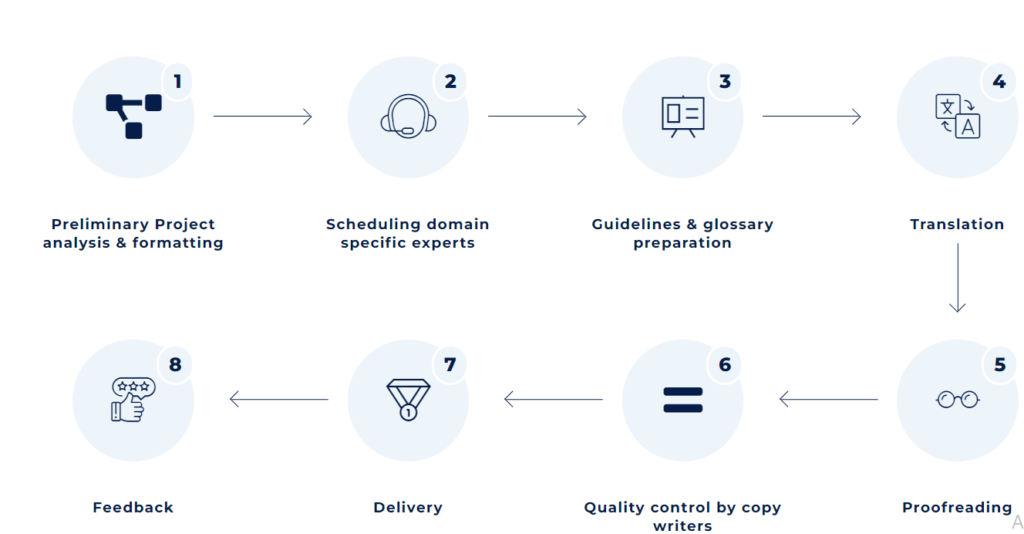The concept of localization is like an engine to a car representing an organization. Without it, it is next to impossible to expand your brand. Are you at that stage of your business career where you have developed your mobile app but are struggling to make it global?
If yes, then dive deep into the article to know about the best app localization tips which will help you to increase the coverage, download rates, and revenue figures of your app.

What is app localization?
App localization is the process of customizing an app’s functionality and user experience for consumers in various target markets.
Mobile app localization involves much more than merely translating the text into the native language. While translation concentrates on the contextual conversion of text from one language to another, localization makes sure that all the components of the app including user interface (UI) elements, particular features, in-app copy, graphics, and app store descriptions are adapted to users’ cultural preferences, habits, or expectations.
Why is app localization important?
App localization is important because it helps businesses to make their place in the global market, grow app engagement, increase app downloads and visibility, and boost sales.
We have a detailed blog post on app localization tools. Do give a read to understand the app localization process better. Now, Let’s take a brief look at all of the mentioned points. Let’s take a brief look at all of the mentioned points.
Global Reach
English is often regarded as the universal language but not everyone is fluent in or comfortable consuming the content in English. Localization enables you to appeal to a wider range of audiences in the international markets and strengthen your brand to bond with them. It is rightly said that if you talk to a man in a language he understands, that goes to his head and if you talk to him in his language, that goes to his heart.
App Engagement:
Users value app content that is catered to their requirements and interests. It significantly improves user experience and can help you increase engagement and brand loyalty. According to research, 75% of mobile consumers are more likely to buy if an online business is localized.
App downloads and visibility
Studies show that app store descriptions in the native language of users can increase app downloads by up to 38%. It is with no doubt that the visibility and exposure of an app are increased when it is localized. Furthermore, getting more downloads from app stores in different regions improves overall rankings because monthly active users are one of the criteria to rank better in app stores.
Revenue
By making investments in localization, one can drastically boost both market share and income streams by expanding into other countries.
9 best app localization tips
Here are some of the app localization best practices
1. Define your profitable regions
There are more than 7,100 languages that are spoken in the world but practically, you cannot localize your app in all these languages due to budget constraints. Therefore, you must define your target audience and should pick up the languages that they speak most frequently.
2. Focus on one language at a time
Localization is a time-consuming process and there are expenses associated with it. You should consider your budget when planning to localize your app, and plan the stages if necessary. This will help you to implement modifications on a wider scale and with more accuracy. Additionally, it offers better quality control, ensuring that your app develops gradually with just one goal at a time.
3. Always look for professional linguists or good app localization services
Even though the internet is flooded with low-cost or even free translation services like Google Translate, they are not necessarily trustworthy. Always hire a professional native speaker or the best, an app localization service that can understand your product and cater to your needs.
4. Revise your source text
Before initiating the app localization process, make sure that the source language is exactly how you want it to be. Review the source text and resource files. It is easier to make adjustments in English (or the native tongue of your software) rather than employing translators for minor errors.
5. Know the structure of your app
The sizing problem is the most common issue faced while mobile app localization. An English word when translated into a target language like German may be longer or shorter than the space intended for it. As a result of the text expansion or text shrinkage, elements like CTA buttons or text overruns may overlap. Knowing in advance which components of your app can be changed in case of such issues would make your app localization process smoother.
6. Be careful of cultural differences
When choosing a mobile app localization service, make sure that the service provider is aware of the culture and regional preferences of your target audience. Different cultures may perceive a given sign differently, which sometimes creates a negative user experience. The same also applies to the use of informal speech and slang terminology. Despite your best efforts, these cultural differences may occasionally restrict the reach and user engagement of your marketing activities. Therefore, be extra mindful of cultural differences.
7. Pay sincere attention to pictures
You need to pay attention to the translation of videos, pictures, and links including the text when localizing mobile applications. Review all these elements of your app and ensure that they are in the right location. Remember that localization is not a mere translation. You should take care of all other aspects of your app.
8. Don’t forget about the color
The meanings of colors vary among cultures. For instance, red represents strength and bravery in India but denotes grief in Africa. You must also localize your app’s color scheme, from the background to the fonts, in addition to the pictures and text.
9. Test your app
The most important stage of localizing a mobile app is testing. You must test the app with your team and then with the locals who speak the target language. Find volunteer testers for each location where you intend to localize the app, and have them go through every function and even the smallest details so that any disparities can be addressed right away. Localized testing will also show whether the app’s user interface and functions are consistent across languages or whether they still require improvements.
How do I get my app localized?
The app localization process involves a series of steps.
Step 1: Conduct market and competitor research to define your target languages
Carrying out market and competitor studies aids in identifying prospective new markets to localize the app. Take your time, research what your key rivals are doing, and figure out how to improve your app using the information you’ve gained over time.
It’s crucial to keep in mind that each market is distinct. Because of this, localizing for some markets can be easier than others. Knowing every detail about each one will enable you to exactly determine what you’ll need to succeed and whether the effort is even worthwhile. In a nutshell, it will help you to find your target languages.
Step 2: Find a top-notch translation service
The main advantage of hiring a professional linguist is that they are aware of any cultural anomalies and can immediately bring them out while translating the content. Believe me, you don’t want to compromise on quality and then pay for it by losing your app users.
Step 3: Create an XML file and submit it for translation
You must generate an XML file containing every string that is there in your app so that it can be quickly translated into another language by a professional linguist.
Depending on the size of your app and the number of strings, the translation process itself may take a few days after you’ve submitted the content for translation. To ensure that there is no misunderstanding regarding the context of what is said, you can post comments next to problematic strings.
Step 4: Translate non-string content
Translation of your app’s strings is only one aspect of localization. Additionally, you should translate text, audio, video, date format, numbers, and currency.
Some of these components might be difficult to translate, or you might even need to modify some of the app’s functionality to make them work well together. However, be careful not to omit any of the necessary stages.
Step 5: App store optimization
It is vital to localize the information on your app’s Google Play or App Store page. As part of the initial interaction with the product, you want each app user to read the content in their native language. If you fail to accomplish this, it can lead to a lack of downloads.
Step 6: Collect the finished translation
Now, it’s time to pick up the finished translation from the translation agency. Before the implementation of the translations, make sure to double-check all of them because mistakes can happen. By doing this, you can guarantee that each string translation makes sense and has the appropriate width. After that, testing may begin as soon as you import the newly translated XML file into your app.
Step 7: Test the localized app internally
Smoke testing is the method that is most frequently used to test freshly inserted localized strings. It involves a functional test that doesn’t require the tester to know the target language.
Their responsibility is to test the app’s operation, which requires some amount of familiarity with the method. Such a test aims to find out whether the localization had any adverse effects on the app’s performance.
Step 8: Serve the users
After the internal testing, launch the app to users and make sure to get their valuable feedback. At this point, there is still a chance for eventual glitches because there is always a possibility of human error. It’s critical to maintain an open mind and base decisions on information and feedback.
Hope you have understood the detailed app localization process. But even after reading this, if you are confused and overwhelmed by these complex steps, try app localization services like Naarg.
Naarg is a data media company based in India which is known for delivering high-quality outputs to its clients. We believe in providing 100% customer satisfaction which makes a cut above the rest.
Below is their process of carrying out app localization.
- Preliminary project analysis and formatting
- Scheduling domain-specific experts
- Guidelines and glossary preparation
- Localization
- Proofreading
- Quality control
- Delivery
- Feedback
Choose the best app localization service because quality should not be compromised.
Want to learn more about the ins and outs of app localization services, then visit our website to know more about our services. Feel free to reach us at info@naargmedia.com.

Choose Naarg for the best app localization service because quality should not be compromised.

